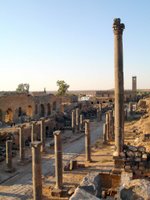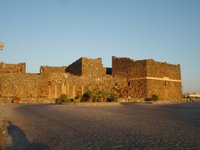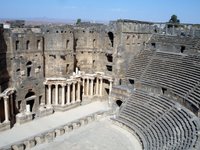Should Visit Place
 Bosra, Situated in the vast Hawran plain, some 145 kilometres south of Damascus. It is an extremely ancient city mentioned in the lists of Tutmose III and Akhenaten in the fourteenth century B.C.The first Nabatean city in the second century B.C.,
Bosra, Situated in the vast Hawran plain, some 145 kilometres south of Damascus. It is an extremely ancient city mentioned in the lists of Tutmose III and Akhenaten in the fourteenth century B.C.The first Nabatean city in the second century B.C.,  it bore the name Buhora, but during the Hellenistic period, it was known by the name of Bustra.Later the Romans took an active interest in the city, and at the time of the Emperor Trajan it was made the capital of the Province of Arabia (in 106 B.C.) and was called Neatrajana Bustra. The city saw its greatest period of prosperity and expansion then, became a crossroads on the caravan routes and the official seat and residence of the Imperial Legate.
it bore the name Buhora, but during the Hellenistic period, it was known by the name of Bustra.Later the Romans took an active interest in the city, and at the time of the Emperor Trajan it was made the capital of the Province of Arabia (in 106 B.C.) and was called Neatrajana Bustra. The city saw its greatest period of prosperity and expansion then, became a crossroads on the caravan routes and the official seat and residence of the Imperial Legate.  After the decline of the Roman Empire, Bosra played a significant role in the history of early Christianity. It was also Iinked to the rise of Islam, when a Nestorian monk called Bahira, who lived in
After the decline of the Roman Empire, Bosra played a significant role in the history of early Christianity. It was also Iinked to the rise of Islam, when a Nestorian monk called Bahira, who lived inthe city, met the young Muhammad when his caravan stopped at Bosra, and predicted his prophetic vocation and the faith he was going to initiate.

The oldest Islamic square minarets (still standing) are found in Bosra, whose prosperous role as an important halt for pilgrims on the way to Mecca lasted until the 17th century. The most interesting part of the city today is the famous Roman theatre built in the second century A.D., which seats 15 thousand spectators, and is considered one of the most beautiful and well-preserved of Roman amphitheatres in the
 world. The stage is 45 meters long and 8 meters deep. Every summer, it hosts Arab and international performers who entertain audiences during the Bosra Art Festival against a majestic background of Roman columns and arches. The city itself contains a great number of Roman ruins, a part of the Byzantine Bahira Church, as well as the al-Mabrak Mosque, which is said to have been erected on the site where the Prophet's camel stopped to
world. The stage is 45 meters long and 8 meters deep. Every summer, it hosts Arab and international performers who entertain audiences during the Bosra Art Festival against a majestic background of Roman columns and arches. The city itself contains a great number of Roman ruins, a part of the Byzantine Bahira Church, as well as the al-Mabrak Mosque, which is said to have been erected on the site where the Prophet's camel stopped to  rest. There is also the Omar Mosque(also called the al-Arouss Mosque), which is the only one of its type remaining from the early days of Islam, and it retains its 7th century primitive form. An important Muslim citadel, dating back to the Ayoubite and Mamluk period still stands, and one of its towers now houses a museum of Antiquities and Traditional Arts.
rest. There is also the Omar Mosque(also called the al-Arouss Mosque), which is the only one of its type remaining from the early days of Islam, and it retains its 7th century primitive form. An important Muslim citadel, dating back to the Ayoubite and Mamluk period still stands, and one of its towers now houses a museum of Antiquities and Traditional Arts. Source: Ministry Of Tourism








18 Comments:
ohhh......nice post!
By Z, at 6/9/06 8:07 PM
Z, at 6/9/06 8:07 PM
This comment has been removed by a blog administrator.
By Z, at 6/9/06 8:07 PM
Z, at 6/9/06 8:07 PM
Thank you Ghalia for the valuable information.
I really enjoyed this post
By Abufares, at 6/9/06 8:32 PM
Abufares, at 6/9/06 8:32 PM
Hi Ghalia,
Greetings from Finland! Good to hear that you found your way down to Bosra, it seems that it was worth the trip :)
It´s getting cold here in Finland and I am busy with work, organizing my new flat and trying to find the time to write my master´s thesis. And I´m missing Syria...
Take care. I hope to hear from you soon again!
By Tanja, at 6/9/06 8:35 PM
Tanja, at 6/9/06 8:35 PM
the next time i am in syria, i should visit some of the places you post about ..
By moryarti, at 6/9/06 8:42 PM
moryarti, at 6/9/06 8:42 PM
Thank you Zaid :), Ammo AbuFares:), and Moryarti:)
Tanja, I was very glad by your comment, I guess I’ve to thank you cuz you motivated me to go there!;)
I wish you al the best of luck, and hope to see you again here in Syria:).
By Ghalia, at 7/9/06 11:43 AM
Ghalia, at 7/9/06 11:43 AM
SORRYYYY .. I am LATE - but better late than never, right?
I always learn something from your blog and I like that a lot! Being an archaeology-lover, that does very much look like my kind of place!!
Thanks so much Ghalia ... I miss you BTW!! How's your brother doing? Say HI for me!!
By Karin, at 7/9/06 2:38 PM
Karin, at 7/9/06 2:38 PM
Did you take these pictures?
By Amr T, at 9/9/06 6:51 AM
Amr T, at 9/9/06 6:51 AM
Hi Amr:), yes I did, like them?
By Ghalia, at 9/9/06 1:07 PM
Ghalia, at 9/9/06 1:07 PM
I Do, what is your camera like? Digital SLR?
By Amr T, at 10/9/06 1:29 AM
Amr T, at 10/9/06 1:29 AM
Sony Cyber-Shot P200!
It's just very normal not a proffesional one!
By Ghalia, at 11/9/06 8:56 PM
Ghalia, at 11/9/06 8:56 PM
wow, you are surely maximizing its capabilities.
By Amr T, at 12/9/06 11:41 PM
Amr T, at 12/9/06 11:41 PM
Those are nice pictures and very sensitive subject. It makes me every time I see such ruins wonder why the best we have is what other colonial nations left for Syria. It is always either Greek ruins, Roman ruins or Crusade ruins. And nothing exactly nothing left by any local rulers. Even current rulers, they are occupying and using the parliament left by the French colonial. What I liked about your posting (comparing with many other site posting information about Syria), is to the first time you stated in front of the pictures the story behind it. Usually, when presented they do not tell the real stories behind it, in a try to conceal original ownership of these ruins. May be this because it will contradict with Arabism call and may be avoid saying we are a mix of Middle Eastern and Medeterian people. Thank you
By Anonymous, at 13/9/06 2:25 PM
Anonymous, at 13/9/06 2:25 PM
GHALIA DEAR ...
I HAVE JUST DECIDED TO TAG YOU!!
:-) HAVE FUN!!
By Karin, at 13/9/06 5:29 PM
Karin, at 13/9/06 5:29 PM
I was fascinated by your pictures od Bosra. They reminded me very much of Mérida in Extremadura. We went there last October, and enjoyed it very much.
Mérida (as I recall) was founded by the Romans, but contains Visigothic and Moorish architecture as well, making it a fascinating place.
You can have a look here: http://www.merida.es/nuvo_nuev.htm
By El Casareño Inglés, at 15/9/06 9:15 PM
El Casareño Inglés, at 15/9/06 9:15 PM
As usual, a most delightful post, and a set of most beautiful pictures..
Thank you Ghalia, and God bless you.
By The Syrian Brit, at 16/9/06 4:34 PM
The Syrian Brit, at 16/9/06 4:34 PM
very nice post..Syria is so Beautiful..
By Anonymous, at 18/9/06 12:42 PM
Anonymous, at 18/9/06 12:42 PM
Ghalia
Where R U ?
By Abufares, at 20/9/06 10:37 AM
Abufares, at 20/9/06 10:37 AM
Post a Comment
<< Home